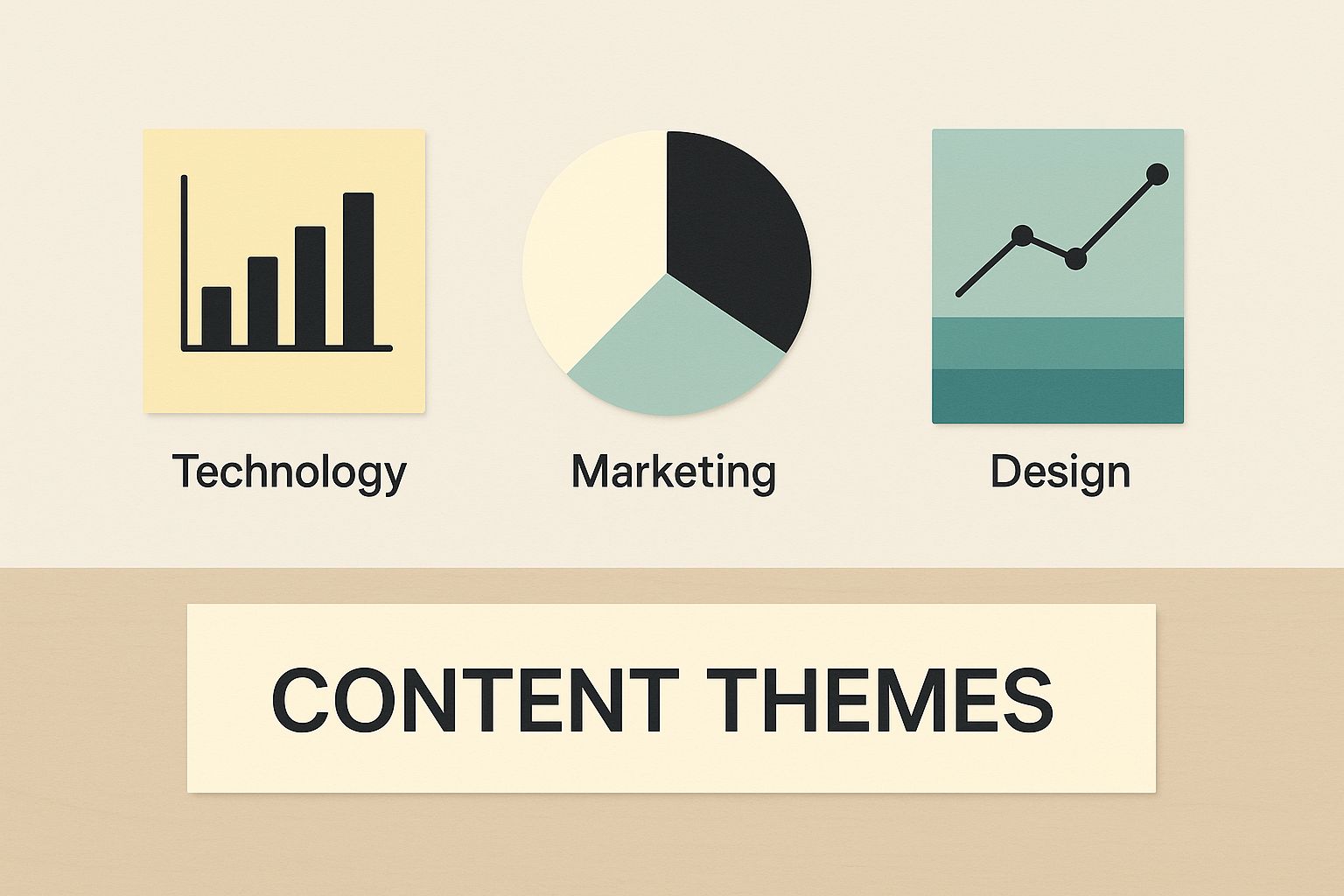
How to Batch Social Media Content Like a Pro: Strategy Guide
Master how to batch social media content with proven strategies from successful creators. Save time, boost consistency, and scale your impact today.
Why Content Batching Changes Everything for Your Social Media
Let's be honest: the daily grind of social media can feel like a relentless content treadmill. You wake up, scramble for an idea, create a post, and before you know it, the day's over and you have to do it all again tomorrow. What if the most successful creators and social media managers aren't just more creative, but simply more strategic? They use a system that separates daily pressure from consistent, high-quality output. This is the heart of content batching: a productivity method where you dedicate focused blocks of time to create a week's or even a month's worth of social media content all at once.
Instead of constantly switching gears between brainstorming, writing, and designing every single day, you get to dive deep into one task at a time. Imagine spending a Monday morning writing all your captions for the month, and a Tuesday afternoon filming all your video clips. This focused approach doesn't just save time; it seriously improves the quality of your work by letting you get into a state of creative flow.
Consistency Trumps Sporadic Brilliance
One of the biggest myths about batching is that it makes your content feel robotic or inauthentic. In reality, the opposite is usually true. When you aren't stressed about what to post right now, you have the mental space to think bigger. You can map out mini-campaigns, tell a cohesive story over several posts, and make sure every piece of content aligns with your core message.
This planned consistency is what builds brand recognition and trust. Sporadic, last-minute flashes of genius are great, but a steady, reliable presence is what keeps your audience engaged and coming back for more. This strategy is essential as brands fight for attention across more and more platforms. For example, with the average person expected to use nearly seven different social networks each month by 2025, posting consistently everywhere without a plan is nearly impossible. This is why over 41% of marketers now see social media engagement as a key measure of their content's success—a metric directly fueled by a steady, thoughtful presence. You can dive deeper into the latest social media statistics and trends to see how this plays out across the board.
From Reactive Scrambling to Proactive Strategy
Ultimately, learning how to batch social media content is about shifting from a reactive to a proactive mindset. It changes your role from a frantic content creator into a thoughtful strategist. You stop asking, "What should I post today?" and start asking, "What story do I want to tell this month?"
This shift frees you up to engage with your community in real-time, jump on relevant trends without derailing your entire schedule, and analyze performance with a clear head. It’s the secret to not only surviving the demands of social media but truly thriving.
Building Your Personal Content Batching Blueprint
A one-size-fits-all content calendar rarely works. To make content batching something you stick with, you need a blueprint that fits your specific brand and, just as importantly, your real-world schedule. The best way to start isn't with a blank page but by looking at what’s already working for you. A quick content audit is the perfect first move.
Find Your Winning Themes
Instead of getting lost scrolling for new ideas, dive into your own analytics from the last few months. Pinpoint the posts that got the most saves, comments, and shares. What did those top performers have in common? Was it a behind-the-scenes video? A quick tip graphic? A customer spotlight? These aren't just random successes; they're direct feedback from your audience.
Once you’ve identified these standout posts, you can reverse-engineer them into repeatable content pillars. These pillars become the core of your batching system. For instance, a local coffee shop might discover their most popular posts fit into three main buckets:
- Educational: Explaining the difference between a light and dark roast.
- Community: Featuring a regular customer and their go-to drink order.
- Behind-the-Scenes: Showing the morning ritual of calibrating the espresso machine.
With these pillars in place, brainstorming becomes much easier. Instead of asking, "What should I post today?" you'll ask, "What's a good educational idea for this week's batch?" This small change helps prevent creative block and keeps your content consistently on point.
This infographic shows a great way to visualize your ideas. By color-coding sticky notes for different themes, you can quickly see your content mix and ensure you have a good balance.

As you can see, a few core pillars can branch out into dozens of specific post ideas, helping you build a balanced and intentional content calendar.
Map Your Ideas Without Overthinking It
With your pillars defined and ideas flowing, it's time to organize them. Don't pressure yourself to create a flawless, month-long schedule right away. Start small by planning just one week. Assign a theme to each day you intend to post. For example: Monday could be "Educational," Wednesday could be "Community," and Friday could be "Behind-the-Scenes."
This simple framework gives you structure without feeling restrictive. It helps you slot your brainstormed ideas into your calendar, turning a messy list into a clear plan. This entire process is a key part of a solid social media content workflow that saves time and improves results. Once you feel comfortable, you can expand from batching one week at a time to two, or even a full month.
Mastering Multi-Platform Content Without Losing Your Mind
Creating content for several platforms at once doesn't mean you have to invent five completely different ideas. The real magic behind an efficient multi-platform strategy is learning how to repurpose, not just recycle. One solid idea can easily fuel your content for an entire week if you know how to adapt it to the unique culture of each platform. This is a huge part of batching social media content effectively.
Think of yourself as a translator. You're keeping the core message intact but speaking the "native language" of each social network. A professional, data-heavy post that does well on LinkedIn will likely fall flat on TikTok, where quick, entertaining videos are what people expect to see.
From One Idea to Platform-Native Posts
Let's walk through a real-world example. Imagine a financial advisor wants to share a tip on the "50/30/20" budgeting rule. The lazy way would be to post the exact same text and graphic everywhere. A strategic approach, however, looks very different.
-
LinkedIn: This is the place for a text-focused post or a clean carousel graphic that breaks down the rule. The caption would be professional, highlighting how this method fosters long-term financial stability and helps career professionals manage their income.
-
Instagram: A visually striking carousel post is perfect here. Each slide could use bold graphics to explain a piece of the rule (50% Needs, 30% Wants, 20% Savings). The caption should be more conversational, asking something like, "Which category is the toughest for you to stick to? Let me know in the comments!" This simple question encourages engagement.
-
TikTok: A fast-paced video is the way to go. The advisor could point to text bubbles that pop onto the screen for each category (50%, 30%, 20%) while a trending audio clip plays in the background. The goal is quick, digestible entertainment that also teaches something in under 30 seconds.
-
X (formerly Twitter): A concise thread works best. The first tweet needs a strong hook: "Struggling with budgeting? The 50/30/20 rule is a game-changer. Here’s how it works 👇." Each following tweet would break down one part of the rule, maybe with a relevant emoji.
This method lets you batch the core idea first, then set aside a block of time to create the specific assets for each platform. You maintain a consistent brand message while respecting each audience by delivering content in the format they love. The payoff is better engagement and a content strategy that feels authentic no matter where you post.
Tools and Systems That Actually Save You Time
A great batching strategy is a game-changer, but the right tools are what really put your workflow on autopilot and give you your time back. It's easy to get lost in the sea of platforms promising to simplify your life, only to find they add more complexity. The goal is to find a system that truly works for you, not against you.
Choosing Your Scheduling Companion
The best scheduling tool feels less like another piece of software and more like a trusted assistant. If you're a solopreneur or a small team just getting started, a platform like Buffer is a fantastic entry point. It has a clean, simple interface that nails the essentials: scheduling, basic analytics, and a clear content calendar. You can get up and running without a steep learning curve or a big budget.
As your team grows, you'll likely need something with more muscle, especially for collaboration. When multiple people are involved in content creation, having a central hub for reviewing, editing, and approving posts is a lifesaver. It keeps mistakes from slipping through the cracks and ensures everything that goes live is perfectly on-brand.
A visual calendar view, like this one from Buffer, is a must-have. It lets you see your entire week or month at a glance.

This kind of layout is crucial for any batching system because it instantly shows you where the gaps are in your schedule and helps you maintain a healthy mix of content.
To help you find the right fit, here's a quick comparison of some popular tools that work well for content batching.
Social Media Scheduling Tools Comparison
Feature and pricing comparison of top content batching and scheduling platforms
| Tool | Free Plan | Key Features | Best Platform Support | Starting Price | | :--- | :--- | :--- | :--- | :--- | | Buffer | Yes (Up to 3 channels) | AI Assistant, clean UI, simple analytics, landing page builder. | Instagram, Facebook, LinkedIn, TikTok | $6/month per channel | | Later | Yes (Limited posts) | Visual planner, Link in Bio tool, hashtag suggestions. | Instagram, TikTok, Pinterest | $25/month | | Sprout Social| No (Free Trial) | Advanced analytics, team collaboration, social listening, approval workflows. | All major platforms | $249/month | | Hootsuite | No (Free Trial) | All-in-one dashboard, team features, social listening, detailed reporting. | All major platforms | $99/month |
This table gives you a starting point, but always consider your specific needs. A tool like Buffer is great for straightforward scheduling, while a platform like Sprout Social is built for larger teams needing deep analytics and collaboration features.
Beyond Scheduling: Building a Content Library
The most efficient social media managers don't just schedule posts—they build a reusable content library. Imagine having your own private bank of evergreen posts, customer testimonials, and top-performing graphics ready to deploy at a moment's notice.
Here’s how to build a library that makes your life easier:
- Use Cloud Storage: Organize everything in Google Drive or Dropbox. Create folders based on your content pillars, like "Educational Tips," "Behind-the-Scenes," or "User-Generated Content."
- Create Your Templates: Use a tool like Canva or our own ViewPrinter to design reusable templates for your most frequent post types. Instead of starting from scratch, you're just swapping text and images. This simple step can easily cut your design time by 75% or more.
- Save Your Greatest Hits: Did a post get amazing engagement? Don't let it be a one-hit-wonder. Save its visual and caption into your library. You can always tweak and repurpose it a few months later.
This system turns content batching from a repetitive chore into a strategic assembly line. You’ll be able to put together weeks of high-quality content in just a fraction of the time.
Reading the Data That Actually Matters for Batched Content
You've done the hard work of planning and creating your content in a big batch. Now, how do you know if it's actually working? It’s tempting to obsess over vanity metrics like your follower count or the number of likes a post gets, but those numbers can be misleading. To figure out if your batching strategy is a success, you need to look at data that shows how your audience is truly behaving.

This means you should worry less about how many people saw your post and more about who took action because of it. Metrics like saves, shares, and thoughtful comments are far more meaningful. They tell you that your content connected so well that someone wanted to save it for later or share it with their own network. These actions are how you build a real community, not just collect a list of passive followers.
A/B Testing Your Batched Content
One of the best—and most underused—perks of batching content is that it sets you up perfectly for controlled experiments. Since everything is planned ahead, you can systematically test different parts of your posts to see what resonates. This is about more than just finding the best time to post.
Here are a few simple tests you can run with your next batch:
- Test Your Hooks: Take two similar video posts. Use the same visuals but write two completely different opening lines in the caption. Does a question-based hook lead to more comments? Does a bold, declarative statement get more shares?
- Vary Your Calls-to-Action (CTAs): On a few posts with similar visuals, try out different CTAs. Does directly asking people to "save this for later" actually boost your save rate more than asking them to "tag a friend"?
- Experiment with Formats: One week, post a helpful tip as a carousel. A couple of weeks later, share the same tip but as a short-form video. Compare the results. Which format got more meaningful engagement or sent more traffic to your website?
When you track these small tests, your batched content becomes a powerful learning tool. You’ll start to see clear patterns in what your audience loves, which helps you make your next batch even more effective. This focus on engagement isn't just a good idea—it's becoming standard. In fact, 53% of marketers now see social media and website engagement as their most important metrics to track. As social algorithms continue to prioritize interaction, this data-focused approach is critical for growth. You can learn more about the rise of engagement-focused marketing strategies and what it means for your brand.
By treating your batched content as a series of learning opportunities, you can turn a confusing analytics dashboard into a clear roadmap for success. If you're ready to dig into your numbers, our guide on understanding social media analytics is a great place to start.
Dodging the Pitfalls That Make Batched Content Feel Robotic
Let's be honest, the biggest fear when you learn how to batch social media content is sounding like a robot. You worry your posts will come across as stiff, disconnected, or completely tone-deaf to what's happening right now. It's a real concern. While scheduling content weeks in advance is liberating, it can also make you feel out of sync with your community. The secret is to weave flexibility into your structured system.
The most common mistake is thinking automation handles everything, including engagement. It doesn't. Your posts might be scheduled to perfection, but the conversations they start are live and unpredictable. This part is non-negotiable: you must be present to engage when your content goes live. Answering comments and DMs is what keeps your pre-planned content feeling human and builds real relationships.
Staying Flexible in a Fast-Moving World
A completely rigid content calendar is destined to break. Online culture moves fast, and a trend that's hot today could be cringe by next Tuesday. To avoid posting something that misses the mark entirely, you need a game plan for adapting on the fly.
Here are a few ways to keep your batched content feeling fresh and relevant:
- Have a "Pause" Button: Know exactly how to halt your entire content queue in your scheduling tool. When major news breaks, the first thing you should do is pause everything. A cheerful promotional post during a sensitive cultural moment can do serious damage to your brand.
- Use a "Flex" Slot: Don't schedule every single minute of your calendar. Leave one or two open slots each week just for timely posts. This gives you room to jump on a trending sound or a relevant conversation without throwing your whole system off track. It's planned spontaneity.
- Do a Morning Check-in: Get into the habit of spending 15 minutes each morning reviewing that day's scheduled posts. Does the tone still feel right? Is the caption still appropriate given current events? This quick review is your final defense against an out-of-touch post.
Balancing Automation and Authentic Interaction
Ultimately, successful content batching isn't a "set it and forget it" strategy. It's about creating a system that frees you from the heavy lifting of content creation so you can pour your energy into the human side of things—connection. Your scheduled posts are just the beginning of the conversation. The real value comes when you show up to participate in the discussion you started.
Your First 30 Days of Content Batching Success
Ready to make content batching a real, sustainable habit? It's tempting to try and build a perfect, month-long system overnight, but that's a recipe for burnout. The secret to long-term success is starting small and building momentum. This 30-day roadmap will guide you from feeling overwhelmed to being confidently in control of your social media.
Your First Week: Just Plan for the Next 7 Days
Let's forget about creating a whole month of content right now. Your only mission for this first week is to plan and create enough posts for the next seven days. Think of it as your trial run, a low-pressure way to get started.
Here’s a simple action plan to get you there:
- Day 1: Block out 60 minutes for a brainstorming session. Look at your content pillars and jot down 3-5 post ideas.
- Day 2: Spend another 60 minutes writing the captions for those ideas. Don't overthink it; just get the words down.
- Day 3: Dedicate 90 minutes to creating your visuals. This could be snapping a few photos, designing simple graphics, or recording short video clips.
- Day 4: Take all your finished posts and schedule them using your favorite tool.
Once that's done, take a moment to celebrate. You are officially one week ahead! The goal here isn't perfection; it's proving to yourself that this process actually works and that you can do it.
Weeks 2-4: Build and Scale Your System
Now that you've gotten your feet wet, you can start looking further ahead. During your second week, try batching two weeks of content. By the third week, you might feel confident enough to tackle a full month. This gradual approach prevents you from feeling overwhelmed and makes the entire process feel manageable.
If you ever hit a wall—maybe you run out of ideas or life gets in the way—just scale back to a one-week batch to get your rhythm back. There's no shame in adjusting. This incremental method is the most effective way to learn how to batch social media content without the pressure. You'll shift your mindset from daily scrambling to strategic, long-term planning, one week at a time.
Feeling ready to make this process even smoother? You can supercharge your batching sessions with ViewPrinter, which uses AI to help generate visuals and captions in seconds. Start creating faster with ViewPrinter today.